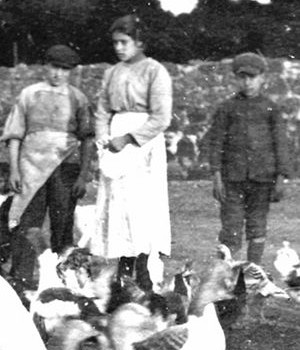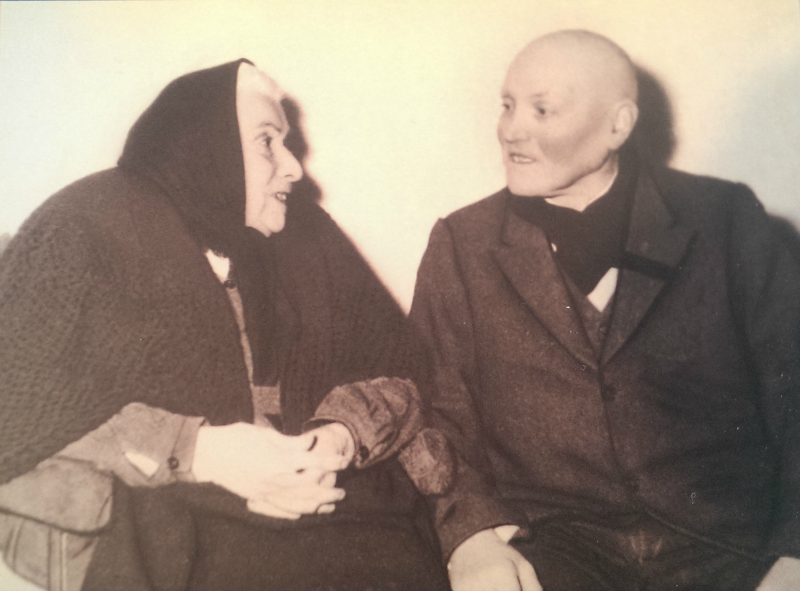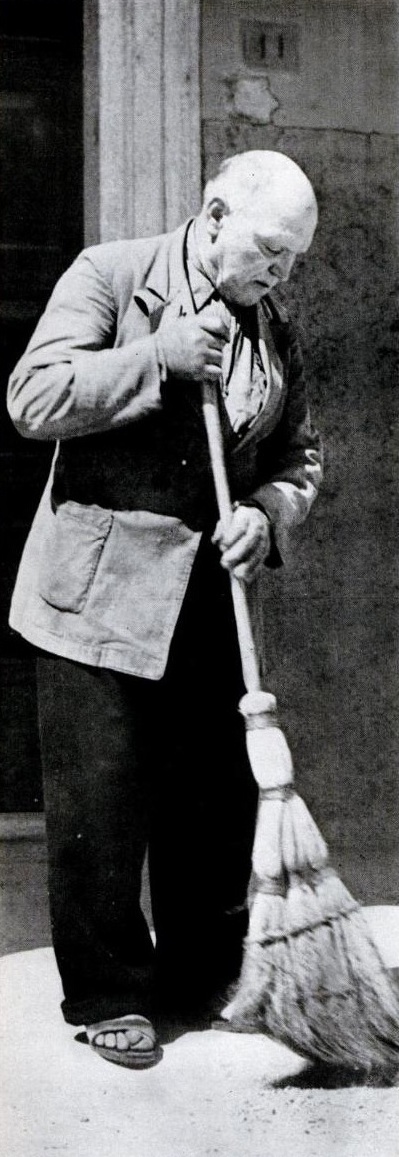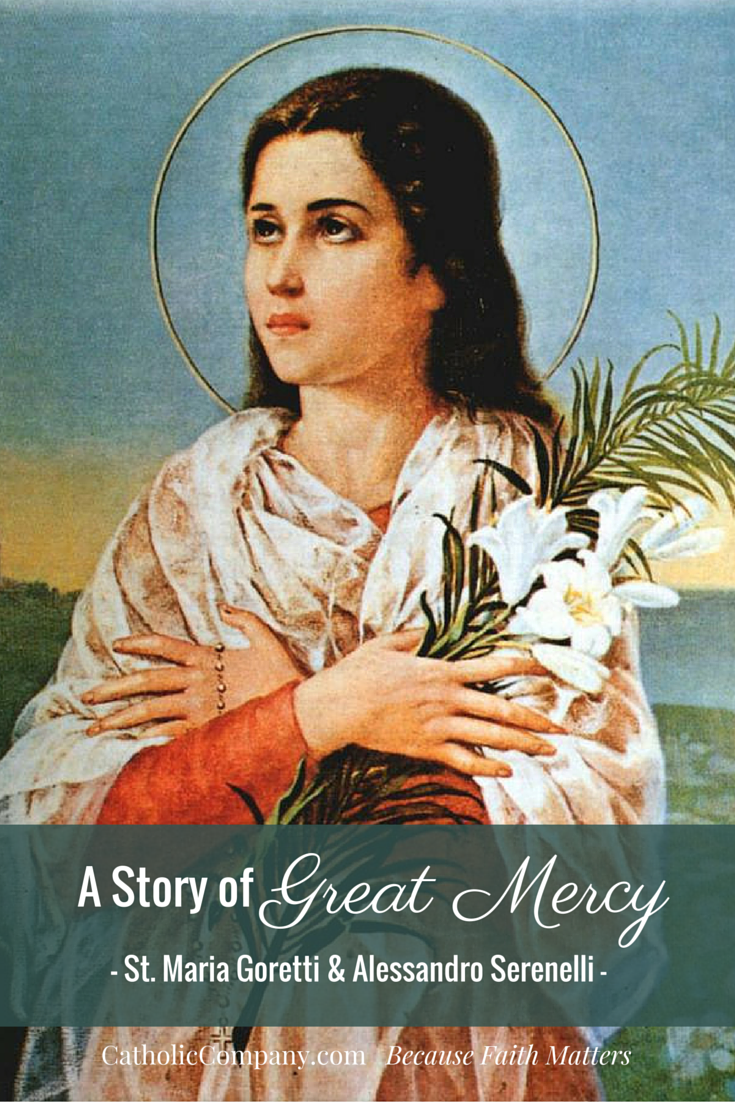A Story of Great Mercy: St. Maria Goretti & Alessandro Serenelli
Jul 05, 2017 by Gretchen Filz
St. Maria Goretti was born in 1890, one of six children from an impoverished farming family in Corinaldo, Italy. In 1899 her father, Luigi Goretti, moved the family to Le Ferriere di Conca, 40 miles from Rome, to work as a sharecropper. In exchange for farming work, the Goretti's lived in the landowner's abandoned factory on the property.
They shared their residence with another poor family, the Serenelli's, which consisted of Giovanni, a widower, and his son, Alessandro. The Serenelli's lived upstairs while the Goretti's lived downstairs. Anything above their crop quota the families could keep for their own needs. In this way they survived poverty and hunger, working side by side.
The farmland was poor, swampy, mosquito infested, and difficult to work. One day Luigi Goretti was bitten by a mosquito carrying the malaria virus. Tragically, he died eleven days later in 1900. Maria was just nine years old.
MARIA'S VIRTUE BEGINS TO SHINE
In order for the Goretti family to survive, Maria's mother, Assunta, took her husband's place in the fields. This left Maria, as the eldest girl, to take her mother's place in the home. Maria cooked, cleaned, did the laundry, and cared for her younger siblings. Additionally, she cooked and cleaned for the two Serenelli men. Maria never complained about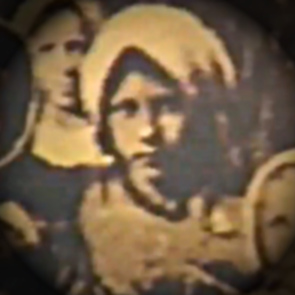 the extra work she had to do; she was a source of encouragement to her mother's worry, assuring her mother that Jesus would provide for their needs.
the extra work she had to do; she was a source of encouragement to her mother's worry, assuring her mother that Jesus would provide for their needs.
Maria was a pious child. Although she could neither read nor write, she learned her catechism and received her First Holy Communion, with great reverence, in 1901 on the feast of Corpus Christi. She went to Mass as often as possible, and grew in virtue, sanctity, maturity, and beauty.
THE DEVIL'S ATTACK ON MARIA'S VIRTUE
Alessandro, the young man with whom her family shared an adjoining residence, was a rough youth with a poor religious upbringing. His mother died in a psychiatric hospital when he was a baby, and his father was an alcoholic. Alessandro himself was given to drinking, swearing, and callous behavior. He had impure thoughts toward Maria, and when he would find her alone in the kitchen, which the two families shared, he would speak to her crudely and make sexual advances. Maria, in her great love for God, abhorred his behavior, rebuked his evil suggestions, and told him, "No, never, that is a sin! God forbids that and we would go to hell!"
This sexual harassment continued for months, and Maria and did her best to avoid him. She was in a precarious situation that was manipulated by Alessandro. Maria kept quiet about the abuse because Alessandro would help his mother with the more difficult tasks in the field; and, even if she did speak up to her mother about what was happening, the family had nowhere else to go. Instead, Maria remained silent and entrusted herself to Jesus.
MARIA GORETTI BECOMES A MARTYR FOR PURITY
On July 5th, 1902, Alessandro's evil intentions came to a head. Maria was inside the house working on the sewing and caring for the younger children while everyone else was out threshing in the fields. Seizing an opportunity for evil, Alessandro left his work, came up the steps and into the kitchen, and closed the door behind him. He approached Maria with a file used to sharpen farm tools, the end of which he had sharpened to a point. He told Maria that if she did not finally allow him to have sex with her, he would kill her.
Maria, now a strong child rooted in her love for Jesus, refused. She cried, "No! It is a sin! God does not want it!" As he moved to overtake her, Maria fought him off bravely. She told him she would rather die than allow him to do what he wanted to do to her. In a rage, Alessandro stabbed Maria nine times. The file passed through Maria's tiny body from the front all the way through her back, again and again. Alessandro was 20 years old, and Maria was 11.
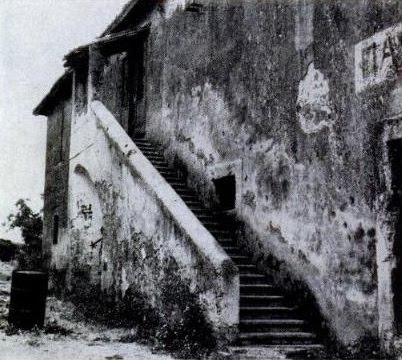 The warehouse where the Goretti family lived. St. Maria was attacked in the kitchen at the top of these stairs.
The warehouse where the Goretti family lived. St. Maria was attacked in the kitchen at the top of these stairs.
After the attack Maria lost consciousness. Alessandro, thinking he had killed her, went into his room and shut the door. However, Maria soon regained consciousness and managed to crawl over to the door and open the latch in order to cry out for help. Alessandro, hearing the creak of the latch, came back and stabbed her five more times. He attacked her with such force that the file bent when it hit her spine.
Maria was found by Giovanni, Alessandro's father, in a pool of blood. Miraculously, Maria was still alive and conscious. When her mother asked her who had done this to her, Maria was able to identify Alessandro as her attacker. She was then rushed to the hospital while Alessandro was taken off to jail.
THE PASSION OF ST. MARIA GORETTI
At the hospital, the doctors tried to save Maria's life. She was badly dehydrated due to a massive loss of blood. Dehydrated, she begged again and again for water. Because her intestines were pierced and its poisonous content was seeping into her body, the doctors couldn't give her any water, as this would exacerbate her already life-threatening condition.
A parish priest was called to give Maria her Last Rites before a risky operation was begun to save her life. The priest showed Maria a crucifix and told her that Jesus was also very thirsty as he suffered his torture on the cross; he asked Maria if she would offer up her thirst to Jesus for the salvation of sinners. Maria agreed, and didn't ask for water again.
The doctors began their surgery on each of Maria's fourteen wounds. Because she was so weak, they couldn't use any anesthesia. Maria was fully conscious as they widened each of her wounds in order to sew them up from the inside out. She didn't cry out in pain once. She endured her agony in quiet and perfect patience, offering it all up to Jesus.
Despite the efforts of the doctors, they couldn't control Maria's bleeding or infection. After twenty excruciating hours of suffering, Maria died the next day on July 6th at the age of 11 years and 8 months. In her last moments the priest asked Maria to forgive her attacker. Her last words were “I forgive Alessandro Serenelli … and I want him with me in heaven forever.”
LIFE AFTER THE CRIME
A week after Maria died, Assunta, with destitution now added to her poverty, no longer had any means to support her remaining five children while also raising them. She had to give each of them up for adoption.
Alessandro, when he was brought before the judge, pleaded innocence. He claimed that he was defending himself against Maria attacking him. Of course the judge knew Alessandro was lying, and, as he was a minor, he was sentenced to 30 years in prison instead of a life sentence. Alessandro's bad behavior continued in prison. Because he was an angry young man in constant fights, he was placed in solitary confinement. He was completely unrepentant for his crime and his heart was hardened.
ALESSANDRO'S CONVERSION
However, six years later, Maria appeared to Alessandro in a dream while he was in prison. She handed him 14 white lilies, the symbol of purity, without speaking a word—one flower for each time he stabbed her. Alessandro understood this to mean that Maria had forgiven him for his crime and that she was now with God in heaven. As a result of this dream, his heart was miraculously converted. He called for the bishop, confessed his crime, and lived out the rest of his sentence as a reformed man and model prisoner. In fact, he was let out of prison three years early due to his good behavior. Maria had become his special patron and intercessor.
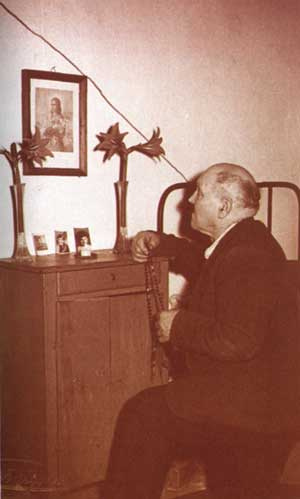 Alessandro Serenelli, now a reformed man, venerating an image of the girl who he killed - St. Maria Goretti. Note the flowers in the vase - the kind she gave to him in a vision.
Alessandro Serenelli, now a reformed man, venerating an image of the girl who he killed - St. Maria Goretti. Note the flowers in the vase - the kind she gave to him in a vision.
ASSUNTA FORGIVES ALESSANDRO
After Alessandro was released from prison, now 27 years after the attack, he went right away to see Assunta, Maria's mother. It was Christmas Eve. He knocked on her door and asked her if she knew who he was. She did in fact recognize him as Alessando Serenelli, the man who killed his daughter and destroyed her family.
Alessandro asked Assunta for her forgiveness for what he had done to her. Assunta replied, "If Maria forgives you, and God forgives you, how can I not also forgive you?" The two went together to Midnight Mass and received Holy Communion kneeling side by side. Alessandro also publicly confessed his sin before the congregation and asked for their pardon as well. Assunta then adopted Alessandro as her own son.
ALESSANDRO LIVES A HOLY LIFE
After obtaining Assunta's forgiveness, Alessandro went to live at a Franciscan monastery as a Lay Brother. He did odd jobs and helped the monastery as a porter and gardener. He also helped with the Franciscan-run school, and was so gentle with the children that they called him "Uncle." He was known for living a quiet, peaceful, and holy life. Alessandro's great devotion to Maria Goretti continued until his death in 1970. It is believed by some that Alessandro will also be declared a saint one day, that God did in fact grant Maria's dying wish that he would be with her in heaven.
CAUSE FOR CANONIZATION
The cause for Maria's canonization opened in 1935, with Alessandro himself—her murderer—testifying to her sanctity and heavenly intercession on his behalf. Maria was then beatified in 1947. Assunta, a woman so destitute during her life, was now very rich. She remarks about her daughter's beatification: "When I saw the Pope coming, I prayed, 'Madonna, please help me.' He put his hand on my head and said, blessed mother, happy mother, mother of a Blessed!"
One of the first miracles attributed to St. Maria Goretti's intercession, aside from Alessandro's conversion, was a construction worker who had his foot crushed by a stone. It was unable to be repaired and an amputation was scheduled for the next day. At that time holy cards with a prayer for Maria's canonization were being distributed around Italy. The worker's wife took one of these holy cards and wrapped it in the bandages on her husband's foot. The next morning, when the doctors came to amputate, they found the man's foot completely restored. He returned to work the same day.
Three years after her beatification, Maria Goretti was canonized by Pope Pius XII on June 24, 1950. Alessandro Serenelli was in attendance at that historic ceremony, where the young girl he murdered, and to whom he was now so strongly devoted, was declared a saint—confirming what he already knew to be true.
Maria's canonization Mass was also attended by Assunta, the first time in history that a mother was present to witness the canonization of her own child. Also present were Assunta's four remaining children.
Read A Prayer to St. Maria Goretti
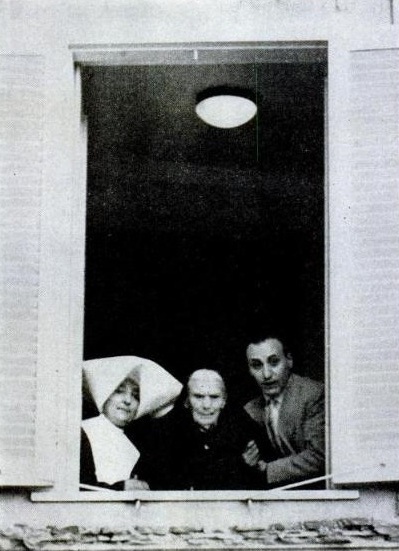 Assunta Goretti, St. Maria’s mother, watches her little girl being canonized
Assunta Goretti, St. Maria’s mother, watches her little girl being canonizedfrom a window of the Apostolic Palace, June 24, 1950.
Pope Pius XII declared that Maria Goretti, now the Church's youngest canonized saint, was the "St. Agnes of the 20th century," an early Christian super-saint who was also a young martyr for purity, just like Maria. In her canonization homily, he called her "the sweet little martyr of purity."
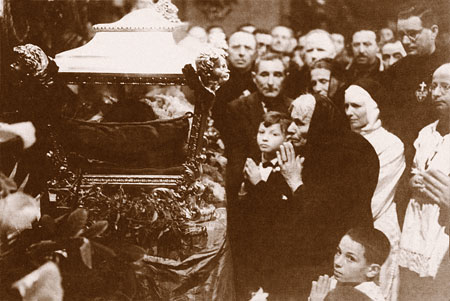 Assunta Goretti, the mother of St. Maria Goretti, prays at her daughter's canonization Mass in 1950.
Assunta Goretti, the mother of St. Maria Goretti, prays at her daughter's canonization Mass in 1950.
The crowd that attended Maria's canonization, estimated at 500,000, was the largest ever up to that point in the Church's history. There were so many people that it was the first canonization Mass to be held outdoors in St. Peter's Square, because the massive basilica was too small to hold all the faithful in attendance.
MARIA THE MIRACLE WORKER
Since her canonization, St. Maria Goretti is now a proven miracle worker with countless serious cases attributed to her intercession. The place where Maria lived with her family and was attacked is now a sanctuary and place of pilgrimage. The Sanctuary of Santa Maria Goretti near Nettuno, Italy, the factory-turned-family-home where she was attacked.
There is also shrine dedicated to her memory in the hospital where she passed into eternal life.
St. Maria Goretti's body, kept inside a reliquary enclosed in a wax statue crafted after her likeness, rests in the Basilica of St. Maria Goretti beside the sea in Nettuno, Italy, near the place where she lived and died.
St. Maria Goretti's relics toured the U.S. East Coast on a Pilgrimage of Mercy from September 2015 through early 2016. Now known as the "Little Saint of Great Mercy," her story is teaching us the great things that God can do through us when we choose to forgive. Her relics are healing many hardened hearts, and in many cases, she is healing bodies too.
If you have the opportunity to venerate the relics of this saint, who is only increasing in popularity and miracles in our modern times, you do not want to miss it!
Continue reading: Video: St. Maria Goretti's Relics Venerated by Thousands in Charlotte
This article has been updated and was originally published in October 2015. © The Catholic Company






